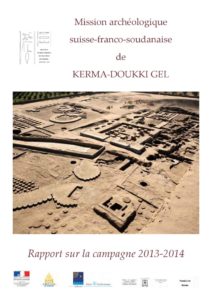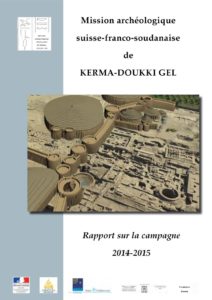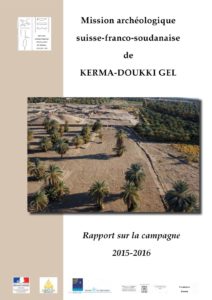Objectives
Current documentary objectives of the mission Swiss-french-Sudanese Kerma-Doukki Gel.
For 50 years, we have acquired a single knowledge of the urban topography of two metropolises located at the southernmost borders of Egypt. On the one hand Kerma, the Nubian capital of the kingdom of Kouch, made it possible to understand the organization of a city whose certain institutions follow the Pharaonic models. The network of circulation, large monuments and the habitat give the impression of a very organized center where quadrangular buildings are protected by round enclosures influenced by the regional tradition. In addition, Doukki Gel, the first results of our work make it possible to discover an unknown architecture which privileges oval constructions or circular whose plans are undoubtedly attached to central Africa. One could thus restore an urban area where were to meet the persons in charge of the military coalitions which, with the king of Kerma, sought to block the projection of the Egyptian troops which wanted to control the exchanges with the South.
After being intervened in the Nubian capital, we considered it important to recognize the vestiges belonging to the Egyptian occupation which intervenes under the reign of Thoutmosis 1st (around 1480 before J. – C.). It becomes possible to follow the integration of the Egyptians vis-a-vis the local populations, to note the effects of colonization and to study Pharaonic architecture with nearly 1000 km of Thèbes, its capital. The excavation of the former levels revealed the remains of monuments except standards which did not have anything comparable with the nilotic cultures. This architecture presented complex characters making the proof that a long tradition had made it possible to work out defense systems or to build large buildings according to still ignored principles of construction of the specialists in the discipline. The methods of archaeology having evolved, there appeared essential to make progress our ideas relating to a territory remained terra incognita.
For 8 years, our objectives have turned to the origins of a African architecture remained in the lapse of memory. The releases provided an extraordinary documentation which relates to the strange choices of populations of which we are unaware of almost completely the development with the third and second millenia before J. – C. All is new and our interrogations multiply because it is difficult to define the birth of the complex States of the black continent. The research tasks for these periods are non-existent. It is true that our experiment of the Egyptian archeology and Nubian is determining to be able to build a new history of Africa. To be able to have the vestiges of these three currents of influence on the same site is obviously a unique opportunity that it is necessary to seize while being conscious of the chronological questions. Whereas Egypt has textual and archaeological data exceptional making it possible to reconstitute its history, Kerma and its allies of central Sudan are located on the other side of the ancient world. One knows well the military program established by the Egyptians on the second cataract as of the Ancient Empire and it is particularly interesting to find in Doukki Gel the defense systems set up by the Nubian and African people. The fortifications are singular, quite different from the known models. One notes the presence of many circular towers and bastions joined, forming faces which had to appear effective, if one believes the high number of the defensive lines of it. Ground and raw brick constructions, armies of pieces of wood, are unceasingly modified, and the effort of the indigenous builders is considerable. We try to understand the techniques used by analyzing the foundation units. The large buildings from 50 to 70 m length, with their hundreds of columns, show astonishing characteristics. Thus the palaces, the halls of entry as the temples are designed with a great rigour.
The objectives of the Mission are thus multiple because they stick to a heritage complicated to emphasize. Raw brick masonries support the reconstructions and the often modified levels present successive plans, always renewed. One thus observes several superimposed states of a city of which plans adapting to several forms of town planning. While seeking to save documentation, it is important to understand the urban development. It appears useful to put at the disposal of a public widened the impressive examples of the achievements implemented in an old city of 3000 or 4000 years. By taking care to preserve the ancient structures, it is also essential to make them readable. Our objectives are obligatorily of a scientific nature, but the safeguard of the vestiges and the presentation of the site to the visitors remain concerns which are justified for a population in search of its identity. The recent discoveries that the formation of the States in Africa illustrates met a lively interest and should make it possible to continue an investigation which explains the relations between two worlds. The research of the identity of the authors of this architecture so different from that which one observes in the city close to Kerma is also a priority concern. The answers depend however on the possible setting at the day of archaeological indices in Doukki Gel and potential architectural comparisons in regions currently not very accessible to a scientific research, like Kordofan or the Darfur, or which remain to be located precisely, like the country of Pount.
2013-2014
- Interventions in the septentrional sector
- Work epigraphic, study of archaeological furniture and paléo-environmental analyses
- Intervention in the Western sector
- Restoration works and of development
Download the archaeological report
2014-2015
- Interventions in the north-western sector
Geomagnetic prospection - Intervention in the Eastern sector
- Ceramic Study, work epigraphic and archeozoology
- Restoration works and of development
Download the archaeological report
2015-2016
- .Interventions in the north-western sector
Geomagnetic prospection - Intervention in the Eastern sector
- Ceramic Study, work epigraphic and archeozoology
- Restoration works and of development
Download the archaeological report
2016-2017
- Interventions in the northern zone of extension
- Interventions in the north-western sector of the concession
- Statements topographical
- Restoration works and of development
Download the archaeological report




